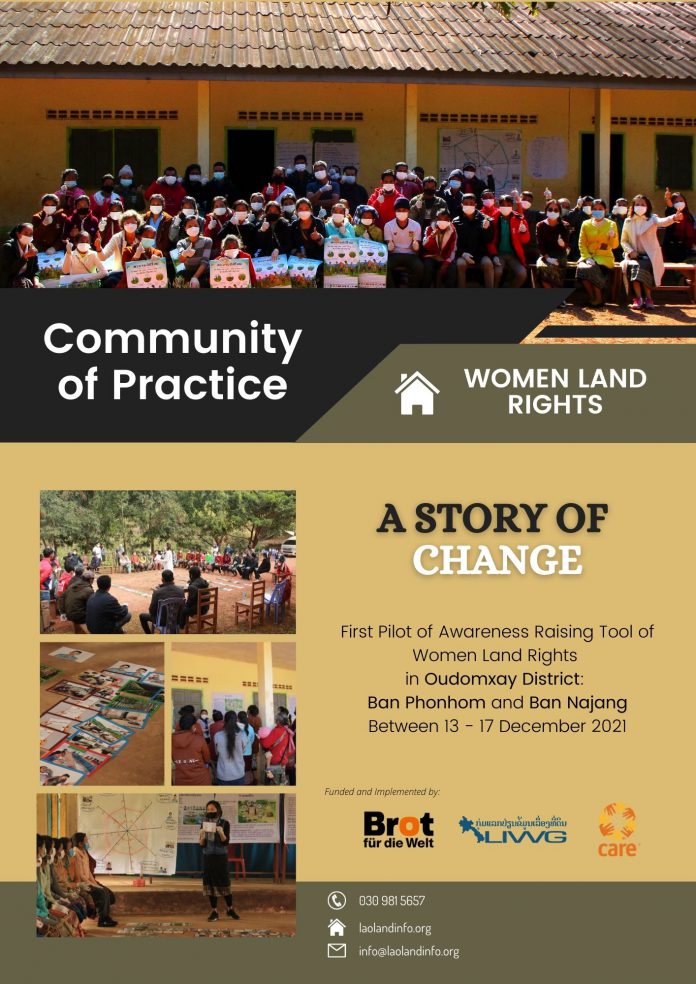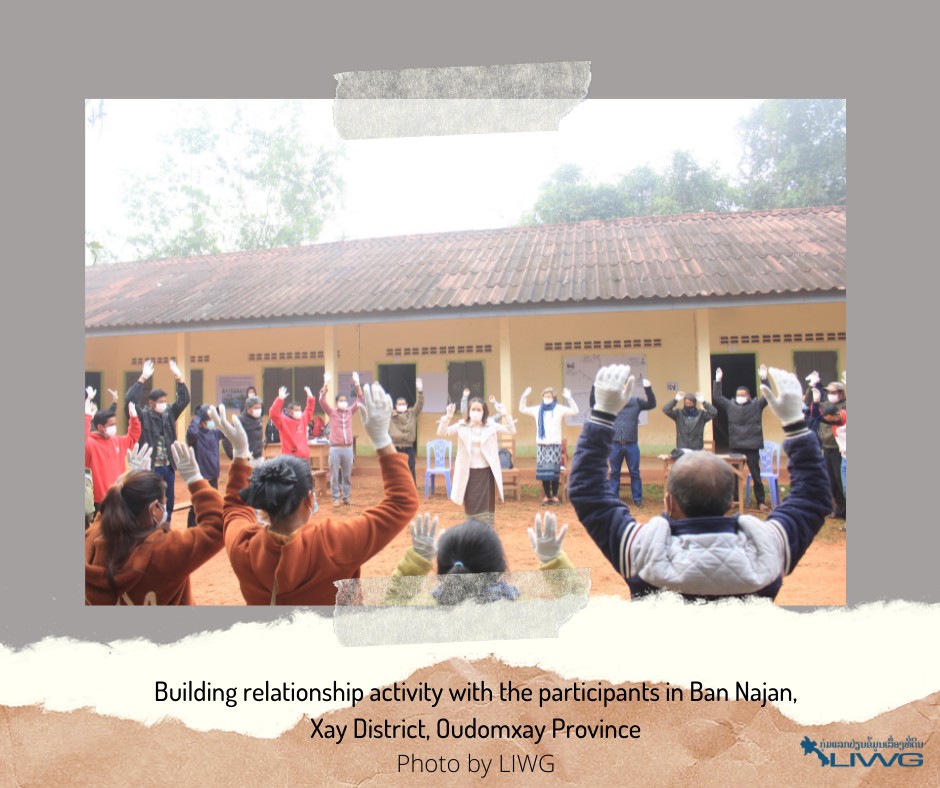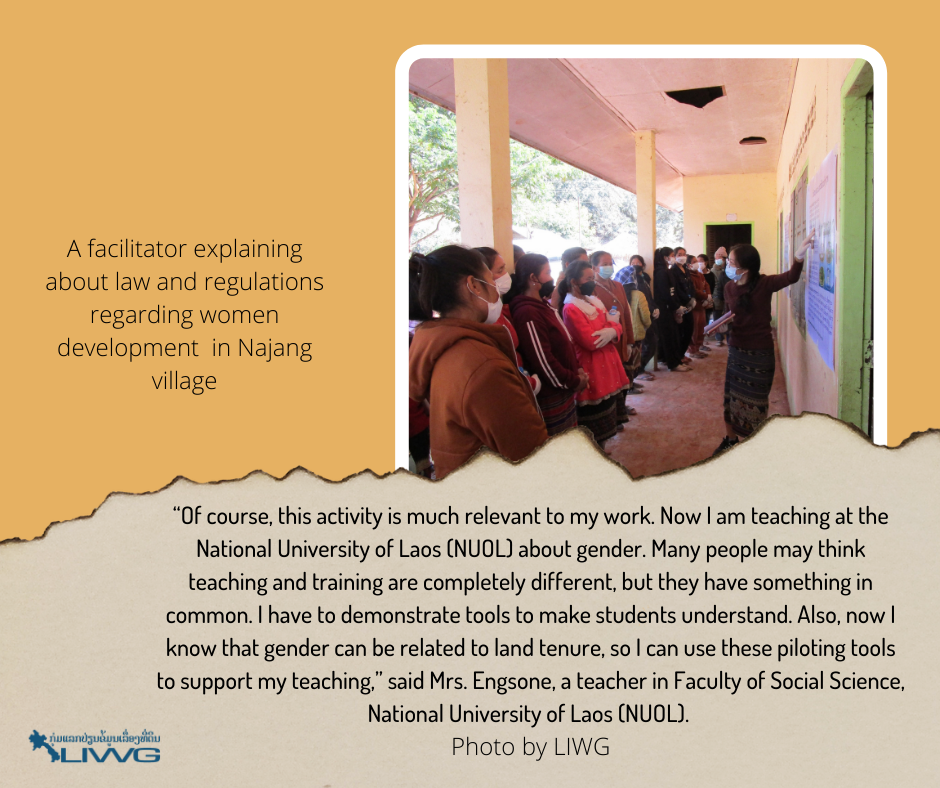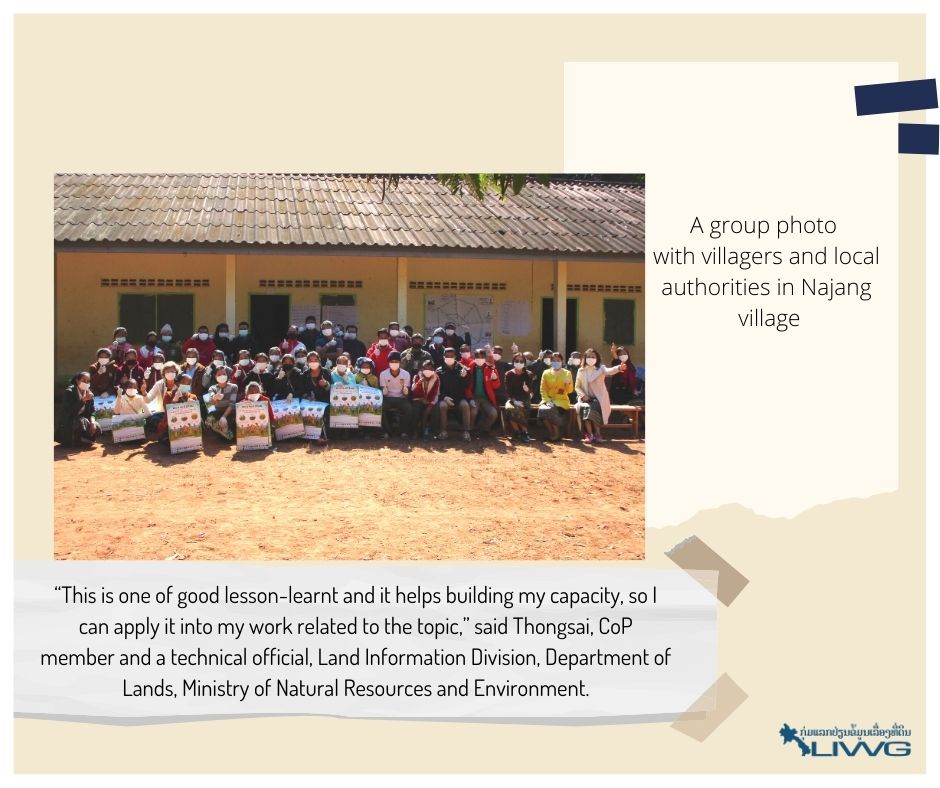
by LIWG and CoP WLR members
“Gender and land rights are not someone else’s job, but it is everyone’s job in the community to be aware of the importance of land rights. Helvetas is one of the LIWG members’ parts of this CoP. Our work is to raise awareness of people on their land rights in the community”
said Viengkhone Ketlouay, CoP member and Project Manager of Gender and Social Equity Coordinator, Helvetas Laos.
How did the community of practice in women land rights happen?
Nowadays, women account for more than 50 % of farmers. They always have been the key players ensuring households food security, yet their access to and control over land often seem more restricted than that of men. Little knowledge is existing about the situation of women’s tenure rights, and consequently rare are the practices to protect them. The revised Land Law (2019) does not make any reference to equal land rights of women anymore. Land title allocation to both husband and wife are no longer indicated in the land law, even though it is mentioned in the sub-legislation, which could be challenging in practice for securing equality of land rights between women and men.
LIWG has received funding to create a Community of Practice (CoP) composed of LIWG members, a gender consultant, representatives from DOL/MONRE and NUOL to work on Women Land Rights to work on Women Land Rights. This is a following work for the past studies that LIWG conducted on the topic, aiming at supporting LIWG and its members to mainstream gender into their respective work. This comes as well as preparatory for future activities which will be carried out by LIWG and LIWG members in raising awareness on land rights for the next 3 years. The project’s goal is to strengthen women’s rights on land in project areas of the LIWG Community of Practice member organizations. Also, this project aims to strengthen women’s rights on land in the 2 pilot communes through the Community of Practices.
Where was the first pilot conducted?
In order to ensure that the awareness raising tools developed are effective, LIWG decided to organize and support two pilots at the project site of the CoP members. 2 members have shown interest in the pilot: Oxfam in Oudomxay and Helvetas in Champasack Province.

This story is about the first pilot which was conducted in Oudomxay. It took place in 2 villages (Ban Ponhom and Ban Najang) in Xay district, Oudomxay province where are the target villages under of Responsible Rubber Investment’s project. Both villages are in mountainous landscape about an hour driving from the town. There are composed of 2 main ethnic groups: Khmu and Lue. Most of them are farmers. In the past, farmers used their land for subsistence agriculture and grow diverse crops for food and sell. In year govern issues the national policy of turning land into capital. This policy comes with promotion of mono cask crop plantation and open for foreigner investors. Chinese rubber companies were invited to invest in the village. Later on, farmers changed and planted rubber trees in order to produce rubber to sell to Chinese companies. To use the lands, 2 types of contracts farming are in place. One type of contract is signed to use collective with a group of villages. The other type of contract is signed with individuals. Therefore, Oxfam in Laos in partnership with the Provincial Chamber of Commerce and Industry in Oudomxay, representative the business community in the province undertaking business negotiations and dealing with trade and labor issues with a view to expanding trade and investment. The Chamber also seeks approaches to address the need of Lao businesses and facilitate the businesses to operate in a friendly business environment. Especially engagement the companies to ensure that the companies follow the responsible agriculture investment practices by adapts the guidelines to the Lao context, initially developed by the China Chamber of Commerce of Metals, Minerals and Chemicals and Vietnam Rubber Group, and pilot them by engaging with rubber companies via the chambers of commerce and industry. Now it is in piloting process and aimed to publish in the middle of the year 2022.
Indeed, Oxfam with the support from Mekong Regional Land Governance (MRLG) on Improving the Responsible Rubber Investment Practice in Cambodia and Laos.
How was it implemented?
The study tour took place from the 13th to 17th of December 2021 in the 2 villages of Ban Ponhom and Ban Najang in Xay district.
Many participants from different organizations and freelance consultant joined, such as the secretariat of Land Information working Group (LIWG), Oxfam Laos, Helvetas Laos, gender experts and representatives from the government, such as Ministry of Natural Resources and Environment (from DoL), University of Laos (Women’s Studies Center, Faculty of Social Science), Provincial Office of Natural resources and environment (PONRE), Provincial Agriculture and Forestry Office (PAFO), Lao Women Union, and Lao Front for National Development. As the purpose of the pilot was to test the tools, and the CoP members engaged in facilitating themselves the awareness raising activities listed in the facilitation guide. Activity 1: Get Familiarized with the Community on gender and land use information, Activity 2: Create an Understanding of Gender on Land and Analyze the Impacts – Benefits, and Activity 3: Law and Regulations Regarding Land and Gender.

Many villagers both women and men joined the awareness raising session. Therefore, it was really useful for the CoP to collect their feed-backs for improvements, but also to see their reaction to this new form of activity.
“I like them all. What I am aware and understand the most from the activity is sharing activity about the inheritance related to land rights, emphasizing the importance of gender equality when the parents allocate their property to their children equally“
said a 50-year-old woman in Phonhom village.
In both villages, villagers face few problems in common. In general, the villagers have enough land to use, and the forest is well-managed by categories following the government policy and regulation. However, the biggest concerns in both villages are related to the protection of communities’ resources such as land and forest. In regard to the women land rights’ aspect, parents rather give land to their sons than daughters because of the traditional customs which rely on the rule that sons will take care of them when they get older. Last and not least, when couples get married, many land certificates are mostly signed in men’s names.
What change could this activity bring to the community?
Obviously, even both villages still face genders and land issues; they also have potentials to change these issues thanks to a better understanding on genders and land rights. After 2 pilots in Phonhom and Najang, we discovered that the participants became more mindful about their rights on land and equality in their families and communities. Also, women became more encouraged to speak their thoughts through sharing session during activities. This is a significant step for villagers; especially men to look in different perspectives and respect women’s rights and abilities regarding decision-making in future of the community development.

Since the activity is related to land, women’s land rights and gender, it requires long term practice in communities. This is a remarkable and innovative activity for two piloting areas. It might be a good start and model to practice with villagers. Increasing the awareness of people land rights in the village and mostly gender equality and land rights will contribute to a more fairfull community development.
“I now understand more the gender equality. For the household chores, if I (wife) am very busy, husband will help. I can also join village’s meetings and decision-making on land. Also, when I do the land title/certificate, I will ensure that we have both husband’s and wife’s names in the title and certificate”
said a 40-year-old woman in Najang village.

What lesson learnt did we find out?
Throughout piloting the tools in 2 villages, this is a crucial beginning in strengthening and raising awareness on women’s rights on land. In addition, this becomes a meaningful lesson learnt to CoP members, such as team-working, management, building capacity among members, monitoring, and working with villagers and local authorities at provincial and district levels. With these practices, the pilot of the awareness raising tools could happen in Oudomxay in order to test the tools and distribute to many more areas.
“I learned many things about gender topic. I learned about the importance of gender equality and laws regarding the natural resources and land management. This activity is very good”
said a young woman between 25-28 years old in Phonhom village.

During the pilot of awareness raising tools in Oudomxay, the CoP was also accompanied by a video film maker who films the practice of the tools. The video will serve as a support to the training of facilitators on the awareness raising tools as well as to promote the awareness raising tools.
This was our first pilot of awareness raising tool that we implemented. For the next pilot, we have planned to implement the second piloting session where Helvetas operates, in Paksong district, Champasack province on the 14th of February 2022.


